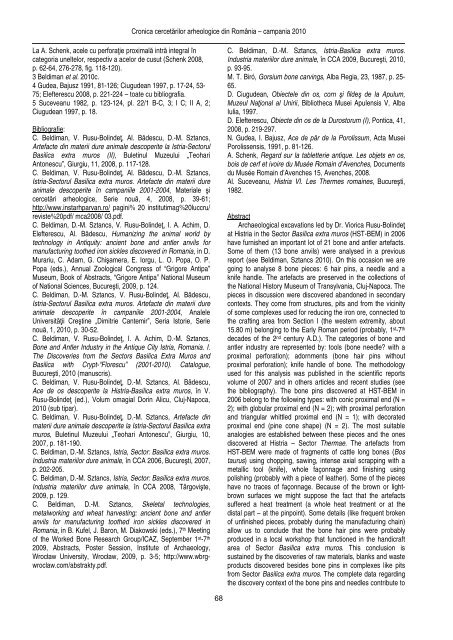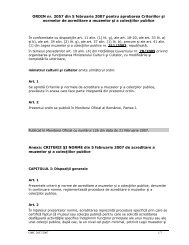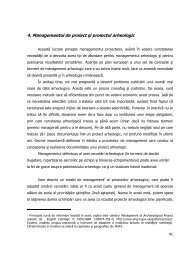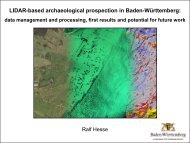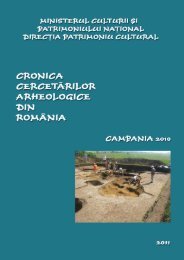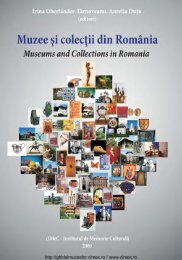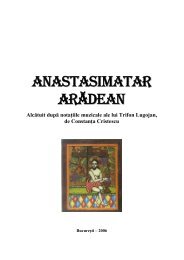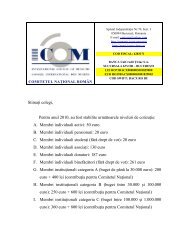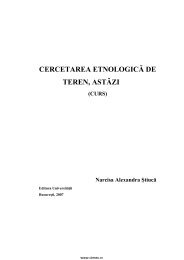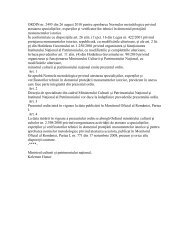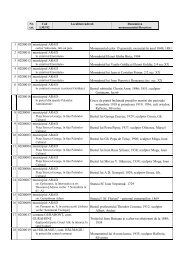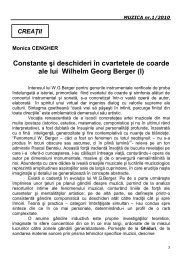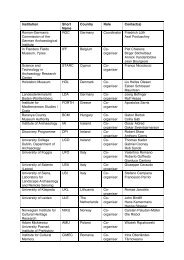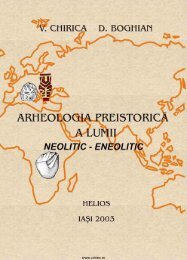Cronica-cercetarilor-arheologice-campania-2010 - cIMeC
Cronica-cercetarilor-arheologice-campania-2010 - cIMeC
Cronica-cercetarilor-arheologice-campania-2010 - cIMeC
Create successful ePaper yourself
Turn your PDF publications into a flip-book with our unique Google optimized e-Paper software.
La A. Schenk, acele cu perforaţie proximală intră integral în<br />
categoria uneltelor, respectiv a acelor de cusut (Schenk 2008,<br />
p. 62-64, 276-278, fig. 118-120).<br />
3 Beldiman et al. <strong>2010</strong>c.<br />
4 Gudea, Bajusz 1991, 81-126; Ciugudean 1997, p. 17-24, 53-<br />
75; Elefterescu 2008, p. 221-224 – toate cu bibliografia.<br />
5 Suceveanu 1982, p. 123-124, pl. 22/1 B-C, 3; I C; II A, 2;<br />
Ciugudean 1997, p. 18.<br />
Bibliografie:<br />
C. Beldiman, V. Rusu-Bolindeţ, Al. Bădescu, D.-M. Sztancs,<br />
Artefacte din materii dure animale descoperite la Istria-Sectorul<br />
Basilica extra muros (II), Buletinul Muzeului „Teohari<br />
Antonescu”, Giurgiu, 11, 2008, p. 117-128.<br />
C. Beldiman, V. Rusu-Bolindeţ, Al. Bădescu, D.-M. Sztancs,<br />
Istria-Sectorul Basilica extra muros. Artefacte din materii dure<br />
animale descoperite în campaniile 2001-2004, Materiale şi<br />
cercetări <strong>arheologice</strong>, Serie nouă, 4, 2008, p. 39-61;<br />
http://www.instarhparvan.ro/ pagini% 20 institutimag%20luccru/<br />
reviste%20pdf/ mca2008/ 03.pdf.<br />
C. Beldiman, D.-M. Sztancs, V. Rusu-Bolindeţ, I. A. Achim, D.<br />
Elefterescu, Al. Bădescu, Humanizing the animal world by<br />
technology in Antiquity: ancient bone and antler anvils for<br />
manufacturing toothed iron sickles discovered in Romania, in D.<br />
Murariu, C. Adam, G. Chişamera, E. Iorgu, L. O. Popa, O. P.<br />
Popa (eds.), Annual Zoological Congress of “Grigore Antipa”<br />
Museum, Book of Abstracts, “Grigore Antipa” National Museum<br />
of National Sciences, Bucureşti, 2009, p. 124.<br />
C. Beldiman, D.-M. Sztancs, V. Rusu-Bolindeţ, Al. Bădescu,<br />
Istria-Sectorul Basilica extra muros. Artefacte din materii dure<br />
animale descoperite în campaniile 2001-2004, Analele<br />
Universităţii Creştine „Dimitrie Cantemir”, Seria Istorie, Serie<br />
nouă, 1, <strong>2010</strong>, p. 30-52.<br />
C. Beldiman, V. Rusu-Bolindeţ, I. A. Achim, D.-M. Sztancs,<br />
Bone and Antler Industry in the Antique City Istria, Romania. I.<br />
The Discoveries from the Sectors Basilica Extra Muros and<br />
Basilica with Crypt-“Florescu” (2001-<strong>2010</strong>). Catalogue,<br />
Bucureşti, <strong>2010</strong> (manuscris).<br />
C. Beldiman, V. Rusu-Bolindeţ, D.-M. Sztancs, Al. Bădescu,<br />
Ace de os descoperite la Histria-Basilica extra muros, în V.<br />
Rusu-Bolindeţ (ed.), Volum omagial Dorin Alicu, Cluj-Napoca,<br />
<strong>2010</strong> (sub tipar).<br />
C. Beldiman, V. Rusu-Bolindeţ, D.-M. Sztancs, Artefacte din<br />
materii dure animale descoperite la Istria-Sectorul Basilica extra<br />
muros, Buletinul Muzeului „Teohari Antonescu”, Giurgiu, 10,<br />
2007, p. 181-190.<br />
C. Beldiman, D.-M. Sztancs, Istria, Sector: Basilica extra muros.<br />
Industria materiilor dure animale, în CCA 2006, Bucureşti, 2007,<br />
p. 202-205.<br />
C. Beldiman, D.-M. Sztancs, Istria, Sector: Basilica extra muros.<br />
Industria materiilor dure animale, în CCA 2008, Târgovişte,<br />
2009, p. 129.<br />
C. Beldiman, D.-M. Sztancs, Skeletal technologies,<br />
metalworking and wheat harvesting: ancient bone and antler<br />
anvils for manufacturing toothed iron sickles discovered in<br />
Romania, in B. Kufel, J. Baron, M. Diakowski (eds.), 7 th Meeting<br />
of the Worked Bone Research Group/ICAZ, September 1 st -7 th<br />
2009, Abstracts, Poster Session, Institute of Archaeology,<br />
Wrocław University, Wrocław, 2009, p. 3-5; http://www.wbrgwroclaw.com/abstrakty.pdf.<br />
<strong>Cronica</strong> cercetărilor <strong>arheologice</strong> din România – <strong>campania</strong> <strong>2010</strong><br />
68<br />
C. Beldiman, D.-M. Sztancs, Istria-Basilica extra muros.<br />
Industria materiilor dure animale, în CCA 2009, Bucureşti, <strong>2010</strong>,<br />
p. 93-95.<br />
M. T. Biró, Gorsium bone carvings, Alba Regia, 23, 1987, p. 25-<br />
65.<br />
D. Ciugudean, Obiectele din os, corn şi fildeş de la Apulum,<br />
Muzeul Naţional al Unirii, Bibliotheca Musei Apulensis V, Alba<br />
Iulia, 1997.<br />
D. Elefterescu, Obiecte din os de la Durostorum (I), Pontica, 41,<br />
2008, p. 219-297.<br />
N. Gudea, I. Bajusz, Ace de păr de la Porolissum, Acta Musei<br />
Porolissensis, 1991, p. 81-126.<br />
A. Schenk, Regard sur la tabletterie antique. Les objets en os,<br />
bois de cerf et ivoire du Musée Romain d’Avenches, Documents<br />
du Musée Romain d’Avenches 15, Avenches, 2008.<br />
Al. Suceveanu, Histria VI. Les Thermes romaines, Bucureşti,<br />
1982.<br />
Abstract<br />
Archaeological excavations led by Dr. Viorica Rusu-Bolindeţ<br />
at Histria in the Sector Basilica extra muros (HST-BEM) in 2006<br />
have furnished an important lot of 21 bone and antler artefacts.<br />
Some of them (13 bone anvils) were analysed in a previous<br />
report (see Beldiman, Sztancs <strong>2010</strong>). On this occasion we are<br />
going to analyse 8 bone pieces: 6 hair pins, a needle and a<br />
knife handle. The artefacts are preserved in the collections of<br />
the National History Museum of Transylvania, Cluj-Napoca. The<br />
pieces in discussion were discovered abandoned in secondary<br />
contexts. They come from structures, pits and from the vicinity<br />
of some complexes used for reducing the iron ore, connected to<br />
the crafting area from Section I (the western extremity, about<br />
15.80 m) belonging to the Early Roman period (probably, 1 st -7 th<br />
decades of the 2 nd century A.D.). The categories of bone and<br />
antler industry are represented by: tools (bone needle? with a<br />
proximal perforation); adornments (bone hair pins without<br />
proximal perforation); knife handle of bone. The methodology<br />
used for this analysis was published in the scientific reports<br />
volume of 2007 and in others articles and recent studies (see<br />
the bibliography). The bone pins discovered at HST-BEM in<br />
2006 belong to the following types: with conic proximal end (N =<br />
2); with globular proximal end (N = 2); with proximal perforation<br />
and triangular whittled proximal end (N = 1); with decorated<br />
proximal end (pine cone shape) (N = 2). The most suitable<br />
analogies are established between these pieces and the ones<br />
discovered at Histria – Sector Thermae. The artefacts from<br />
HST-BEM were made of fragments of cattle long bones (Bos<br />
taurus) using chopping, sawing, intense axial scrapping with a<br />
metallic tool (knife), whole façonnage and finishing using<br />
polishing (probably with a piece of leather). Some of the pieces<br />
have no traces of façonnage. Because of the brown or lightbrown<br />
surfaces we might suppose the fact that the artefacts<br />
suffered a heat treatment (a whole heat treatment or at the<br />
distal part – at the pinpoint). Some details (like frequent broken<br />
of unfinished pieces, probably during the manufacturing chain)<br />
allow us to conclude that the bone hair pins were probably<br />
produced in a local workshop that functioned in the handicraft<br />
area of Sector Basilica extra muros. This conclusion is<br />
sustained by the discoveries of raw materials, blanks and waste<br />
products discovered besides bone pins in complexes like pits<br />
from Sector Basilica extra muros. The complete data regarding<br />
the discovery context of the bone pins and needles contribute to


